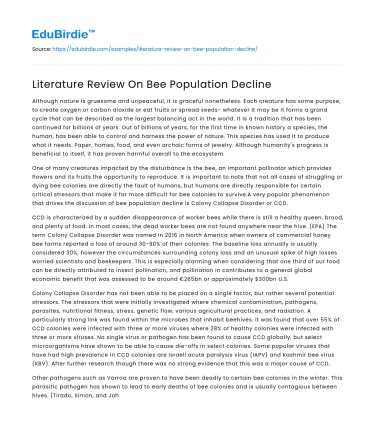Although nature is gruesome and unpeaceful, it is graceful nonetheless. Each creature has some purpose, to create oxygen or carbon dioxide or eat fruits or spread seeds- whatever it may be it forms a grand cycle that can be described as the largest balancing act in the world. It is a tradition that has been continued for billions of years. Out of billions of years, for the first time in known history a species, the human, has been able to control and harness the power of nature. This species has used it to produce what it needs. Paper, homes, food, and even archaic forms of jewelry. Although humanity's progress is beneficial to itself, it has proven harmful overall to the ecosystem.
One of many creatures impacted by the disturbance is the bee, an important pollinator which provides flowers and its fruits the opportunity to reproduce. It is important to note that not all cases of struggling or dying bee colonies are directly the fault of humans, but humans are directly responsible for certain critical stressors that make it far more difficult for bee colonies to survive.A very popular phenomenon that drives the discussion of bee population decline is Colony Collapse Disorder or CCD.
Save your time!
We can take care of your essay
- Proper editing and formatting
- Free revision, title page, and bibliography
- Flexible prices and money-back guarantee
CCD is characterized by a sudden disappearance of worker bees while there is still a healthy queen, brood, and plenty of food. In most cases, the dead worker bees are not found anywhere near the hive. (EPA) The term Colony Collapse Disorder was named in 2016 in North America when owners of commercial honey bee farms reported a loss of around 30-90% of their colonies. The baseline loss annually is usually considered 30%, however the circumstances surrounding colony loss and an unusual spike of high losses worried scientists and beekeepers. This is especially alarming when considering that one third of our food can be directly attributed to insect pollination, and pollination in contributes to a general global economic benefit that was assessed to be around €265bn or approximately $300bn U.S.
Colony Collapse Disorder has not been able to be placed on a single factor, but rather several potential stressors. The stressors that were initially investigated where chemical contamination, pathogens, parasites, nutritional fitness, stress, genetic flow, various agricultural practices, and radiation. A particularly strong link was found within the microbes that inhabit beehives. It was found that over 55% of CCD colonies were infected with three or more viruses where 28% of healthy colonies were infected with three or more viruses. No single virus or pathogen has been found to cause CCD globally, but select microorganisms have shown to be able to cause die-offs in select colonies. Some popular viruses that have had high prevalence in CCD colonies are Israeli acute paralysis virus (IAPV) and Kashmir bee virus (KBV). After further research though there was no strong evidence that this was a major cause of CCD.
Other pathogens such as Varroa are proven to have been deadly to certain bee colonies in the winter. This parasitic pathogen has shown to lead to early deaths of bee colonies and is usually contagious between hives. (Tirado, Simon, and Johnston 24) Although no organism has been shown to explicitly cause CCD, it is very possible for several organisms to cause damage and increase the likelihood for a colony to suffer CCD.One of the more major stressors that has been attributed to CCD are various agricultural practices, mainly man-made chemicals such as insecticides and pesticides. Improper use of pesticides can cause pollen to become toxic to bees and other insects. One pesticide was even revealed to cause neurological damage that caused bees to become disoriented.
One popular insecticide, neonicotinoids, has been strongly linked to CCD. Neonicotinoids are used very frequently globally and have been shown to be extremely toxic to honeybees, and were initially demonstrated to impair neurological processes such as smell and memory. Although honeybees may not be exposed to lethal doses regularly, when combined with the effects of other fungicides the toxicity of neonicotinoids increases significantly. When honeybees are exposed to regular levels of neonicotinoids and fungicides it was shown to have adverse effects that could prove lethal.
Behaviors and processes such as foraging, development, memory, learning, and hygiene were negatively affected. They were also shown to increase the negative impact of other microorganisms. It is clear that neonicotinoids have a negative effect at best on bee colonies. When presented with all the evidence, it is clear that CCD is most likely to be caused by two main factors: harmful microbes and pesticides. Although independently they do not do global damage, and regional damage at most, when synergised and combined they are proven to cause much more damage and impair a bee colonies ability to survive in the wild. However since this is relatively new research and scientists are still conducting research, more time and money is needed to come to a definite conclusion of what exactly is causing CCD. The ties however are extremely clear, man made pesticides that are made to improve crop productivity is shooting the entire world in the foot and it is clear enough that something has to change.






 Stuck on your essay?
Stuck on your essay?

